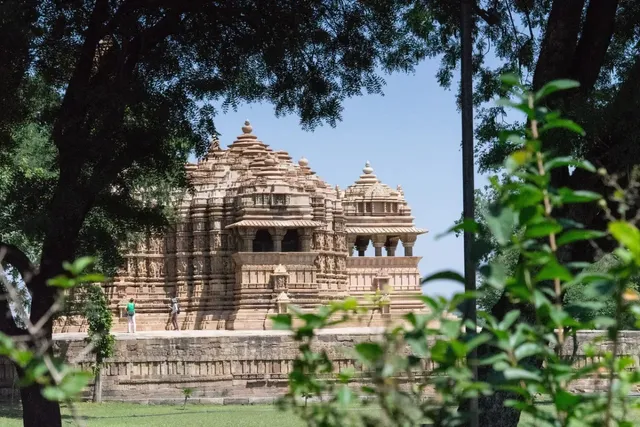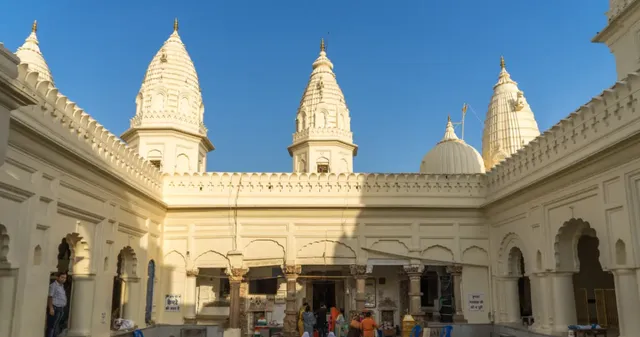The Khajuraho Group of Monuments is a group of Hindu and Jain temples in Chhatarpur, Madhya Pradesh, India, about 175 kilometres (109 mi) southeast of Jhansi. They are one of the UNESCO World Heritage Sites in India. The temples are famous for their nagara-style architectural symbolism and their erotic sculptures.
Most Khajuraho temples were built between 950 and 1050 by the Chandela dynasty. Historical records note that the Khajuraho temple site had 85 temples by the 12th century, spread over 20 square kilometers Of these, only about 25 temples have survived, spread over 6 square kilometers. Of the various surviving temples, the Kandariya Mahadeva Temple is decorated with a profusion of sculptures with intricate details, symbolism and expressiveness of ancient Indian art.
The Khajuraho group of temples were built together but were dedicated to two religions, Hinduism and Jainism, suggesting a tradition of acceptance and respect for diverse religious views among Hindus and Jains in the region.
LOCATION: The Khajuraho monuments are located in the Indian state of Madhya Pradesh, in Chhatarpur district, about 620 kilometres (385 mi) southeast of New Delhi.The temples are located near a small town also known as Khajuraho, with a population of about 20,000 people (2001 Census). Khajuraho is served by Civil Aerodrome Khajuraho (IATA Code: HJR), with services to Delhi, Agra, Varanasi and Mumbai. The site is also linked by the Indian Railways service, with the railway station located approximately six kilometres from the entrance to the monuments .
The monuments are about 10 kilometres off the east-west National Highway 75, and about 50 kilometres from the city of Chhatarpur, which is connected to the state capital Bhopal by the SW-NE running National Highway 86.
The 10th century Bhand Deva Temple in Rajasthan was built in the style of the Khajuraho monuments and is often referred to as 'Little Khajuraho'.
History: The Khajuraho group of monuments was built during the rule of the Chandela dynasty. The building activity started almost immediately after the rise of their power, throughout their kingdom to be later known as Bundelkhand. Most temples were built during the reigns of the Hindu kings Yashovarman and Dhanga. Yashovarman's legacy is best exhibited by The Lakshmana Temple. Vishvanatha temple best highlights King Dhanga's reign. The largest and currently most famous surviving temple is Kandariya Mahadeva built in the reign of King Vidyadhara. The temple inscriptions suggest many of the currently surviving temples were complete between 970 and 1030 CE, with further temples completed during the following decades. The Khajuraho temples were built about 35 miles from the medieval city of Mahoba, the capital of the Chandela dynasty, in the Kalinjar region. In ancient and medieval literature, their kingdom has been referred to as Jijhoti, Jejahoti, Chih-chi-to and Jejakabhukti. Khajuraho was mentioned by Abu Rihan-al-Biruni, the Persian historian who accompanied Mahmud of Ghazni in his raid of Kalinjar in 1022 CE; he mentions Khajuraho as the capital of Jajahuti. The raid was unsuccessful, and a peace accord was reached when the Hindu king agreed to pay a ransom to Mahmud of Ghazni to end the attack and leave. Khajuraho temples were in active use through the end of the 12th century. This changed in the 13th century; after the army of Delhi Sultanate, under the command of the Muslim Sultan Qutb-ud-din Aibak, attacked and seized the Chandela kingdom. About a century later, Ibn Battuta, the Moroccan traveller in his memoirs about his stay in India from 1335 to 1342 CE, mentioned visiting Khajuraho temples, calling them "Kajarra" as follows: ...near (Khajuraho) temples, which contain idols that have been mutilated by the Moslems, live a number of yogis whose matted locks have grown as long as their bodies. And on account of extreme asceticism they are all yellow in colour. Many Moslems attend these men in order to take lessons (yoga) from them. — Ibn Battuta, about 1335 CE, Riḥlat Ibn...
Read moreAwesome 👍 temple , that glorifies our history
This is a Hindu temple called the Kandariya Mahadeva, the largest and tallest of the surviving temples at the temple site of Khajuraho, in central India. It is dedicated to Shiva, who is represented by the linga in the main shrine known as the womb chamber located at the heart of the building.
Hindu temples are designed along axis points that extend from the heart of the chamber upward through the line of the main tower (shikara) and outward in the cardinal directions. The main deity image is located in the central shrine, and the outside of the shrine and the exterior of the temple are richly decorated with sculptures. In some design schemes, one views the entire range of existence looking upwards from bottom to top, with plant and animal life near the bottom and the gods and semi-divine beings in various sculptural registers extending towards the heavens at the temple’s summit. The steeply rising superstructure, and overall mountainous form of this temple are references to the mythical source of creation, the primordial Mount Meru, around which the world came into being.
The Khajuraho temples sit on very large platforms, and it is thought that originally there may have been a lake here beneath them. An association between temple sites and water is appropriate, as an essential part of Hindu worship is ritual bathing, required by the devout in order to purify themselves before entering the sacred area of the temple.
The majority of Hindu temples in north and central India were built between the Gupta period (roughly 300–700 CE) and the 1100s. The temples at Khajuraho are considered among the highpoints of classical Hindu architecture in the northern (nagara) style . This temple and more than 80 others were built by the Chandella kings, who ruled this area of central India between 950–1050 CE. Some temples, such as those at Khajuraho, survived because they were located in remote locations, removed from the conflict and warfare of political and urban centers. Even today, one must fly to Khajuraho, or take a full-day car ride from any other major city center.
Some of the earliest Hindu temples were carved out of living rock and freestanding stone temples evolved gradually after that. Western-style arches and vaults were never used, but masons carved fine sandstone in numerous pieces, which were then assembled and sometimes pinned together using metal rods.
The Khajuraho temples are famous around the world for their fine statuary, many of which depict loving couples, sometimes in erotic poses. These images were disturbing to early European visitors, and even now confound many viewers. Scholars debate the meaning of these images, offering multiple explanations. One interpretation is that they show tantric ritual symbolism. “Tantric” refers to esoteric texts and techniques used in both Hindu and Buddhist practices that offer a direct path to enlightenment or spiritual release using the body’s natural energies as a starting point. Thus, physical pleasure, and more specifically a controlled experience of physical pleasure, could be a path to spiritual achievement. Such imagery may also challenge to the viewer to move beyond the earthly experience of physical pleasure into higher spiritual goals. The location of these loving couples on the temple walls, between the meeting hall portion of the temple and the inner sanctum, seems critical to their interpretation.
Various esoteric and mainstream texts describe sexual activities and postures, including the comprehensively categorical Kama Sutra. It is likely that these erotic sculptures take such texts as the source of their subject matter. Aesthetically, these sculptures are highly sophisticated, expressing virtuosity in their rendering of human figures, expression and interaction, and an extremely imaginative vision of...
Read moreThe Khajuraho Group of Monuments is a group of Hindu temples and Jain temples in Chhatarpur district, Madhya Pradesh, India, about 175 kilometres (109 mi) southeast of Jhansi. They are a UNESCO World Heritage Site.The temples are famous for their nagara-style architectural symbolism and their erotic sculptures.Most Khajuraho temples were built between 950 and 1050 by the Chandela dynasty.Historical records note that the Khajuraho temple site had 85 temples by the 12th century, spread over 20 square kilometers. Of these, only about 25 temples have survived, spread over six square kilometers. Of the surviving temples, the Kandariya Mahadeva Temple is decorated with a profusion of sculptures with intricate details, symbolism and expressiveness of ancient Indian art. The Khajuraho group of temples were built together but were dedicated to two religions, Hinduism and Jainism, suggesting a tradition of acceptance and respect for diverse religious views among Hindus and Jains in the region. The Khajuraho temples feature a variety of artwork, of which 10% is sexual or erotic artoutside and inside the temples. Some of the temples that have two layers of walls have small erotic carvings on the outside of the inner wall. Some scholars suggest these to be tantric sexual practices.Other scholars state that the erotic arts are part of the Hindu tradition of treating kama as an essential and proper part of human life, and its symbolic or explicit display is common in Hindu temples.James McConnachie, in his history of the Kamasutra, describes the sexual-themed Khajuraho sculptures as "the apogee of erotic art": The temples have several thousand statues and artworks, with Kandarya Mahadeva Temple alone decorated with over 870. Some 10% of these iconographic carvings contain sexual themes and various sexual poses. A common misconception is that, since the old structures with carvings in Khajuraho are temples, the carvings depict sex between deities;however the kama arts represent diverse sexual expressions of different human beings.The vast majority of arts depict various aspects the everyday life, mythical stories as well as symbolic display of various secular and spiritual values important in Hindu tradition.For example, depictions show women putting on makeup, musicians making music, potters, farmers, and other folks in their daily life during the medieval era.These scenes are in the outer padas as is typical in Hindu temples. There is iconographic symbolism embedded in the arts displayed in Khajuraho temples.Core Hindu values are expressed in multitude of ways. Even the Kama scenes, when seen in combination of sculptures that precede and follow, depict the spiritual themes such as moksha. In the words of Stella Kramrisch, The Khajuraho temples represent one expression of many forms of arts that flourished in Rajput kingdoms of India from 8th through 10th century CE. For example, contemporary with Khajuraho were the publications of poems and drama such as Prabodhacandrodaya, Karpuramanjari, Viddhasalabhanjika and Kavyamimansa.Some of the themes expressed in these literary works are carved as sculpture in Khajuraho temples. Some sculptures at the Khajuraho monuments dedicated to Vishnu include the Vyalas, which are hybrid imaginary animals with lions' bodies, and are found in other Indian temples.Some of these hybrid mythical artwork include Vrik Vyala (hybrid of wolf and lion) and Gaja Vyala(hybrid of elephant and lion). These Vyalasmay represent syncretic, creative combination of powers...
Read more


